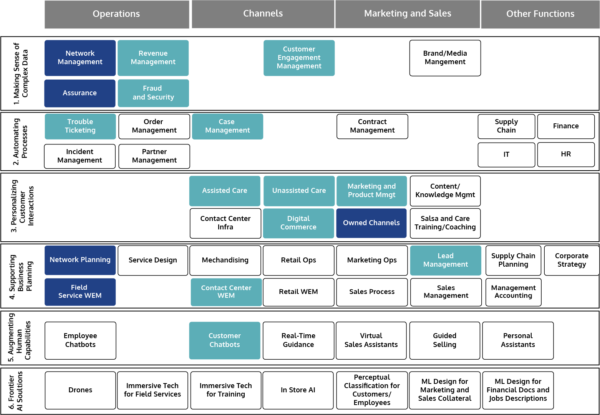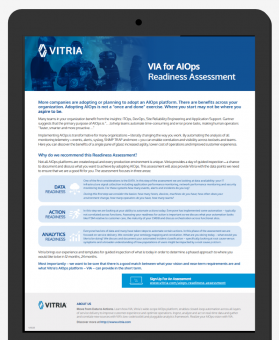Finding the Real Value of Analytics, AI and Automation

The last five years have seen intense focus on the potential financial value of data and a variety of analytics, AI and automation deployed to mine the gold. Understanding and then accessing this value is challenging – datasets need to be clean and available, processes need to be “unbroken”, algorithms need to be fit for purpose and the organization needs to be ready to support and use new capabilities.
For a large and complex organization like a telco – with considerable existing technical debt even before the addition of new data lakes, algorithms, analytical tools, data management capabilities and other data/analytics related capabilities – there is a very real question around return on investment for each project undertaken. The telco needs to understand what projects they could undertake, the likely success of each project and the potential financial upside (in solid measurements such as revenue uplift, capex and opex decrease).
Understanding What to Deploy
The diagram illustrates an exercise to look across a telco at the financial benefit that could be available. The first part of the exercise is to understand what types of analytics, AI and automation (shortened to A3 below) would be useful across the telco’s processes. Six different categories can be found, as per the 6 rows on the diagram:
Row 1: Making sense of complex data – Analytics and machine learning are used to understand large, mostly structured data sets. Looking for patterns, to diagnose problems and predict/prescribe resolutions
Row 2: Automating processes – Intelligent automation and RPA enable decision making, orchestration and task completion within telco processes
Row 3: Personalizing customer interactions – Analytics and machine learning understand customer data, create segmentation, identify triggers and prescribe actions to be taken
Row 4: Support business planning – Analytics and machine learning used in forecasting and optimization exercises.
Row 5: Augmenting human capabilities – AI solutions such as natural language processing and text analytics are used to understand human intent or sentiment. Used within interactions between customers or employees and telco systems.
Row 6: Frontier AI solutions – A number of individual AI solutions which have particular, specialist uses within a telco
The boxes of the diagram describe the various processes that would benefit from the addition A3. The columns divide these processes into: operational uses in the telco’s network and back-office, then processes relating to its channels and marketing/sales teams; with remaining areas in the far right column. The financial value is denoted by the box color.
Financial Value of Analytics, AI and Automation in a “Typical” Telco
Source: Charlotte Patrick Consult, Dec 21
Summarizing the main findings from this exercise:
- High returns on investment for a telco are most likely to be seen where A3 augments large operational and capital-intensive projects (for example, moves toward SDN/NFV)
- A3 offers significant benefit in use cases where large groups of people are involved in repetitive activity – for example, in the contact center. However, expected returns for use cases involving smaller teams can be modest in comparison. For example, an order-handling team reducing the head count by 40 at a $120,000 fully loaded cost (including salary, supervisor’s salary and facilities/building cost allocation), is only $4 million. A good amount – but not in the $10m or $100m savings which are possible from deploying A3 on the network
- Where business cases are modest, it is worth looking to include benefits that might accrue in other parts of the organization. For example, the downstream financial benefit from reducing calls into the contact center when installing new alarm management solutions in the network operations center
- One general trend seen across the diagram is that certain types of use cases offer good “problems” for A3 to solve and others do not. For example, a use case which has large datasets that either change rapidly or require insight to be retrieved from them quickly requires machine learning (ML) in place of rule-based analytics – which would provide an inferior solution or no solution at all.
- However, the fact that the use case offers a strong reason for using A3 does not mean that it necessarily generates a good return, at least in the short term. As demonstrated by the bottom row of the diagram which includes a range of new and intelligent solutions using AI, but which offer very specific solutions with more limited ROI.
Understanding the Financial Value of A3
To look at how the financial value can be understood, we pick one particular box with high value from A3. Labelled “Assurance” in the top left hand corner of the diagram above, this box acts as a good illustration as it requires heavy use of analytics, machine learning and automation.
To calculate financial value, three questions need to be asked:
- What problems need to be solved within the box?
- What solutions can A3 provide?
- How much financial value can be attributed to each solution?
The problems and solutions within assurance are related to the need to understand: the health of the network, the experience of the telco’s customers with their network and devices; and the provision of this insight to a variety of parties (seen in the columns of the diagram below – as the operational teams, customer facing staff in the channels and interested parties in marketing/sales; as well as the telco’s customers in the final column).
The rows on the diagram divide up the wide range of use cases into more simple requirements (labelled as descriptive) which allow a human to track events on the network or to monitor customer experience. These simple uses of A3 become more complex going down the diagram – requiring analytics and machine learning for diagnostics and then to predict future states on the network and, at the bottom of the diagram, to created closed-loop routines which detect or predict issues and run automations to fix the problems detected or expected.
Solutions Provided by A3
Source: Charlotte Patrick Consult, Dec 21
Creating a view of the spread of uses for A3 in assurance allows the telco to move towards calculating value. Each of these use cases needs to be considered for its ability to influence the bottom line. Good questions to be asked for assurance are:
- Does it provide increased efficiency within the network or service operations center?
- Does it reduce truck rolls in field services?
- Does it reduce the amount of spend on network equipment?
Once a decision has been made, the tricky task of ascribing actual financial values can be done. A set of assumptions about the network and teams within a “typical telco” are necessary to allow consistency of calculation – eg. how many headcounts in different teams and yearly spend on the network. As is a determination to keep calculations reasonably simple to allow all interested parties across the organization to understand how value will be generated.
The deployment of analytics, AI and automation as described above is just beginning to mature. Some uses for analytics and Robotic Process Automation are mature and their value understood. But most of the more complex and prescriptive uses for analytics/machine learning are at the stage of being theoretically understood (ie. a telco might know where it can use it and the potential benefit) but are not actually implemented beyond early pilots or small, closely scoped implementations. Wider and more ambitious implementations are often waiting for cleaner data and processes, mature algorithms or more orchestration capabilities. There is often, then, an accompanying cultural and organizational change program which needs to be in place – which can be laborious and represents a 2 to 5 year activity for the telcos.







0 Comments